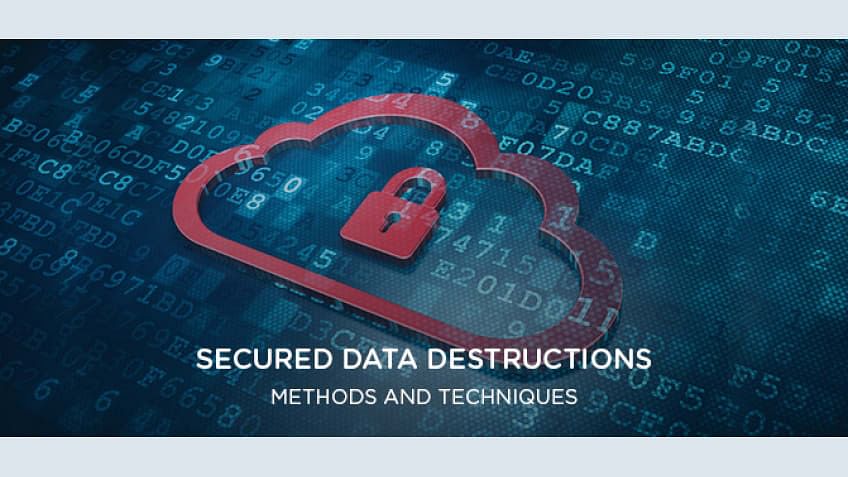Data Destruction Solutions: A Crucial Element in Your Cyber Security Technique
Data Destruction Solutions: A Crucial Element in Your Cyber Security Technique
Blog Article
Discovering the Relevance of Data Destruction in the Context of Computer System Safety And Security Solutions and Protecting Confidential Information
In an age where information violations are significantly common, the value of effective information destruction can not be overemphasized. Organizations must embrace stringent procedures to guarantee that sensitive details is not only shielded during its lifecycle however likewise emphatically gotten rid of when no more required. The techniques used for data elimination, paired with compliance to lawful standards, play a pivotal function in maintaining privacy and trust. However, the ramifications of these practices expand beyond plain compliance, affecting a company's credibility and functional integrity in the digital industry. What techniques can organizations implement to boost their data devastation protocols?
Recognizing Data Devastation
Information destruction is an essential component of computer safety that involves the irreversible elimination of information from storage tools to avoid unapproved gain access to and prospective data breaches. In an increasingly electronic landscape, companies encounter increased risks connected with delicate information being incorrectly accessed or exploited. Effective data destruction safeguards versus these dangers, ensuring that private dataâEUR" such as client details, copyright, and financial recordsâEUR" can not be recouped after disposal.
Recognizing the value of information damage extends beyond simple compliance with lawful and regulatory frameworks; it is vital for preserving organizational stability and depend on. When data is incorrectly managed or improperly damaged, the consequences can be severe, consisting of financial loss, reputational damages, and legal liabilities.

Methods of Information Obliteration

One prevalent method is information wiping, which includes overwriting existing information with arbitrary patterns several times. This method makes the original data irretrievable, making it a preferred choice for organizations looking for to protect secret information.
An additional method is degaussing, which uses an effective magnetic area to interfere with the magnetic domains on storage tools, successfully eliminating the information. This technique is particularly reliable for magnetic media but is not suitable to solid-state drives.
Physical damage is one more durable technique, involving the shredding or squashing of storage space devices. This method guarantees that data recovery is essentially impossible, making it excellent for very sensitive info.
Lastly, security can function as a complementary technique to information removal. By securing data before deletion, companies can add an added layer of protection, making certain that even if remnants are recouped, they stay inaccessible without the decryption secret. Each method must be selected based upon the degree of data level of sensitivity and the details safety and security requirements of the company.
Legal Compliance and Data Protection
Organizations must navigate an intricate landscape of lawful requirements associated with information safety, particularly after applying techniques of information obliteration. Various policies, such as the General Information Defense Regulation (GDPR) and the Medical Insurance Portability and Liability Act (HIPAA), enforce rigorous standards on how organizations need to manage and dispose of sensitive information. Failure to adhere to these regulations can lead to significant legal effects, consisting of significant penalties and reputational damages.
Data destruction processes must be carefully recorded to demonstrate compliance with applicable legislations and requirements. This paperwork not only works as evidence of adherence to legal responsibilities yet also illustrates a dedication to securing delicate details. Organizations must also establish clear policies concerning information retention and damage timelines, ensuring that information is not held longer than needed.

Moreover, routine audits and evaluations of data destruction methods are important to maintain compliance and adapt to developing legal structures (data destruction). By proactively attending to legal requirements, companies can alleviate threats here are the findings connected with information violations and show their dedication to data safety and security. Eventually, prioritizing legal compliance in data destruction procedures is not simply a regulatory obligation, however a fundamental facet of a durable information safety approach
Effect On Business Reputation
The track record of an organization can be substantially influenced by its technique to information devastation and management. In today's digital landscape, where data breaches can happen anytime, the failure to appropriately take care of sensitive info can cause severe repercussions. Organizations that improperly handle data devastation risk exposing personal customer details, which not just breaks personal privacy laws but additionally wears down trust among click here to find out more stakeholders and customers.
A ruined online reputation can result in lowered consumer commitment, as customers end up being reluctant to engage with a business that has demonstrated neglect in safeguarding their information. Moreover, unfavorable promotion surrounding an information violation can have a long-term result, as prospective clients could be deterred by the viewed absence of protection. This can cause a direct decline in income and market share.
Moreover, organizations that focus on information damage as component of their security strategy can boost their online reputation by showcasing their commitment to safeguarding sensitive details. By embracing rigorous data monitoring methods, organizations can not only minimize dangers yet also place themselves as trustworthy entities in their corresponding sectors, thus reinforcing their general brand name picture.

Best Practices for Secure Disposal
Executing ideal methods for protected disposal of information is necessary for minimizing risks related to data breaches and making certain conformity with privacy laws. Organizations should embrace an extensive data disposal plan that lays out procedures for both electronic and physical information damage.
For physical data storage space devices, such as difficult drives, shredding or degaussing is recommended to avoid information recovery. Furthermore, companies must preserve a chain of wardship documentation during the disposal procedure, ensuring accountability and traceability of disposed things.
For electronic data, utilizing software application that complies with market requirements for information cleaning is essential. This software application ought to overwrite existing information several times, making recovery essentially difficult. It is likewise essential to verify the efficiency of the data devastation process through audits or third-party evaluations.
Educating staff members on secure disposal practices adds one more layer of security, as human mistake can usually lead to information exposure. On a regular basis updating and examining disposal policies makes certain alignment with evolving policies and technological improvements. By applying these finest practices, organizations can substantially reduce the threat of unapproved data access and read this article enhance their general data defense approach.
Final Thought
In conclusion, data devastation is an essential facet of computer system protection solutions that makes certain the defense of secret information from unauthorized gain access to. Executing efficient approaches of information elimination, adhering to lawful compliance, and recognizing the influence on service credibility are important components of an extensive information safety technique. By adopting finest methods for safe disposal, organizations can promote trust with clients and guard sensitive data, ultimately adding to a much more safe and secure digital landscape.
In an age where information violations are significantly typical, the relevance of effective data devastation can not be overstated.Data destruction is a crucial element of computer system safety that entails the permanent removal of data from storage space devices to stop unauthorized accessibility and possible information breaches. Organizations ought to additionally establish clear plans concerning information retention and devastation timelines, ensuring that data is not held longer than necessary.
By proactively addressing legal needs, companies can mitigate threats connected with information breaches and demonstrate their dedication to data protection (data destruction). Eventually, focusing on lawful compliance in data devastation procedures is not just a regulative obligation, however an essential aspect of a robust data safety and security technique
Report this page